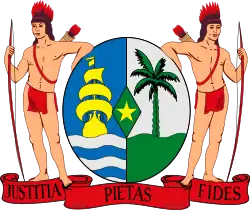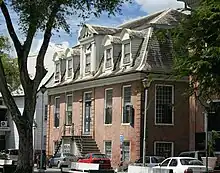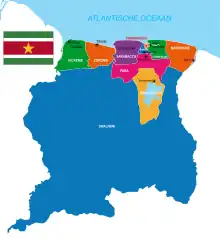 |
|---|
| Constitution |
|
|
Politics of Suriname take place in a framework of a parliamentary representative democratic assembly-independent republic, whereby the president of Suriname is the head of state and head of government, and of a pluriform multi-party system. Executive power is exercised by the government. The executive power is dependent on the Parliament in theory. Legislative power is vested in both the government and the National Assembly.[1][2] The judiciary is independent of the executive and the legislature.[3]
Executive branch
The executive branch is headed by the president, who is elected by a two-thirds majority of the National Assembly or, failing that twice, by a majority of the People's Assembly for a 5-year term. If at least two-thirds of the National Assembly cannot agree to vote for one presidential candidate, a People's Assembly is formed from all National Assembly delegates and regional and municipal representatives who were elected by popular vote in the most recent national election.[4] The Vice President, normally elected at the same time as the president, is elected for a 5-year term, the same way as the president.[5] As head of government, the president appoints a cabinet of ministers who are led in their day-to-day activities by the Vice President.[6] There is no constitutional provision for removal or replacement of the president unless he resigns.
.jpg.webp)
A Staatsraad (State Advisory Council) with a maximum of 15 members, advises the president in the conduct of policy. All but four seats are allotted by proportional representation of all political parties represented in the National Assembly.[7][8] The president chairs the council, and two seats are allotted to representatives of labor, and two are to employers' organizations. The Cabinet of Ministers appointed by the president.[8]
Current formation
Legislative branch
The legislative branch of government consists of a 51-member unicameral National Assembly, simultaneously and popularly elected for a 5-year term.[9]
Political parties and elections
Suriname elects on national level a head of state – the president – and a legislature. The president is elected for a five-year term by an electoral college based on the parliament. The National Assembly (Nationale Assemblée) has 51 members, elected every five years by proportional representation per district.[9]
 | |||||
|---|---|---|---|---|---|
| Party | Votes | % | Seats | +/– | |
| Progressive Reform Party | 108,378 | 39.45 | 20 | +11 | |
| National Democratic Party | 65,862 | 23.97 | 16 | –10 | |
| National Party of Suriname | 32,394 | 11.79 | 3 | +1 | |
| General Liberation and Development Party[lower-alpha 1] | 24,956 | 9.08 | 8 | +3 | |
| Pertjajah Luhur[lower-alpha 1] | 16,623 | 6.05 | 2 | –3 | |
| Reform and Renewal Movement | 7,423 | 2.70 | 0 | New | |
| Brotherhood and Unity in Politics | 6,835 | 2.49 | 2 | 0 | |
| Alternative 2020 | 4,501 | 1.64 | 0 | New | |
| Democracy and Development through Unity | 2,375 | 0.86 | 0 | –1 | |
| Party for Law and Development–Amazon Party | 1,593 | 0.58 | 0 | 0 | |
| Surinamese Labour Party | 922 | 0.34 | 0 | 0 | |
| Progressive Workers' and Farmers' Union | 820 | 0.30 | 0 | –1 | |
| STREI! | 700 | 0.25 | 0 | New | |
| Democratic Alternative '91 | 659 | 0.24 | 0 | 0 | |
| People's Party for Renewal and Democracy | 349 | 0.13 | 0 | 0 | |
| Social Democratic Union | 254 | 0.09 | 0 | New | |
| The New Wind | 70 | 0.03 | 0 | New | |
| Total | 274,714 | 100.00 | 51 | 0 | |
| Valid votes | 274,714 | 96.79 | |||
| Invalid/blank votes | 9,120 | 3.21 | |||
| Total votes | 283,834 | 100.00 | |||
| Registered voters/turnout | 383,333 | 74.04 | |||
| Source: Centraal Hoofdstembureau | |||||
Judicial branch

%252C_2022_-2_(cropped).jpg.webp)
The judiciary is headed by the Court of Justice (Supreme Court). This court supervises the magistrate courts. Members are appointed for life by the president in consultation with the National Assembly, the State Advisory Council, and the National Order of Private Attorneys.[3]
A Constitutional Court was established in 2019.[10]
Administrative divisions

The country is divided into 10 administrative districts, each headed by a District Commissioner appointed by the president. The commissioner serves at the president's pleasure. The 10 districts (distrikten, singular - district) are ; Brokopondo, Commewijne, Coronie, Marowijne, Nickerie, Para, Paramaribo, Saramacca, Sipaliwini, Wanica.[11]
The districts including Paramaribo are further subdivided into resorts. There are 63 resorts in Suriname.[11][12]
See also
Notes
- 1 2 ABOP member Miquella Soemar-Huur was elected as lijstduwer on PL's list in Wanica, and is included in PL's seat total.
References
- ↑ "Het werk van DNA". National Assembly of Suriname (in Dutch). Retrieved 15 July 2020.
- ↑ "Grondwet van de Republiek Suriname - Article 70". Suriname.nu (in Dutch). Retrieved 15 July 2020.
- 1 2 "Grondwet van de Republiek Suriname Article 133". Suriname.nu (in Dutch). Retrieved 15 July 2020.
- ↑ "De Verenigde Volksvergadering". National Assembly (in Dutch). Retrieved 15 July 2020.
- ↑ "Constitution of Suriname, 1987 with reforms of 1992. See Article 83".
- ↑ "Grondwet van de Republiek Suriname Article 113". Suriname.nu (in Dutch). Retrieved 15 July 2020.
- ↑ "Staatsraad". Suriname.nu (in Dutch). Retrieved 15 July 2020.
- 1 2 "Wet Staatsraad". National Assembly of Suriname (in Dutch). Retrieved 15 July 2020.
- 1 2 "Grondwet van de Republiek Suriname Article 55". Suriname.nu (in Dutch). Retrieved 15 July 2020.
- ↑ "WET van 4 oktober 2019, ter uitvoering van artikel 144 lid 4 van de Grondwet van de Republiek Suriname. (Wet Constitutioneel Hof)". dna.sr. Retrieved 1 June 2020.
- 1 2 "Brochure Bestuurlijke Indeling" (PDF) (in Dutch). Archived from the original (PDF) on 2016-02-22. Retrieved 2 July 2020.
- ↑ "District Sipaliwini 1" (in Dutch). Retrieved 2 July 2020.
Pamacca is not in the (old) brochure, and there is one more resort as of 2019.


.svg.png.webp)